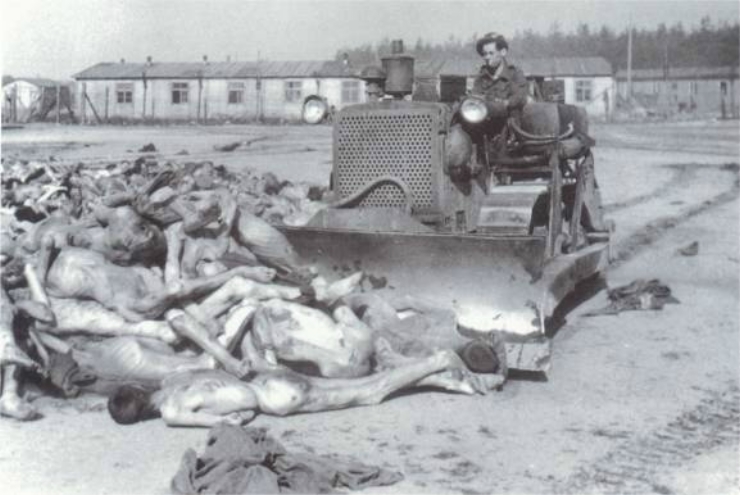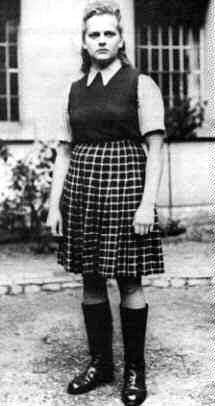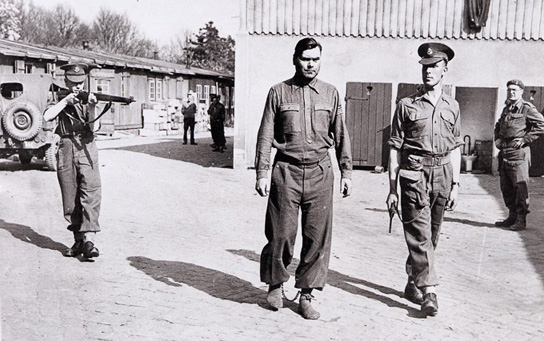[back] Holocaust revisionism

BELSEN
[back]
Holocaust
revisionism
Simon Wiesenthal wrote in 1975 that "there were no extermination camps on German soil."
[Dr. Russell Barton recounts that 53,000 people were moved into Belsen, which had room for only 3,000. An outbreak of typhus killed some 30,000 people, hence the well known pictures of thousands of corpses, that most associate (and are meant to associate) with the holocaust 'gas chambers', also Typhoid from contaminated water, and diarrhoea, hence the chronic loss of weight seen. Same at Dachau.]
See:
Auschwitz-Birkenau
Belzec Buchenwald Dachau Treblinka
Sobibor
US based Camps
Allied Camps
The Lethal Liberation of Bergen-Belsen by Joseph Bellinger
[Dr. Russell Barton] The 'False News' Trial of Ernst Zündel -- 1988
[1995] Bergen-Belsen Camp: The suppressed story By Mark Weber
"No Gassing in Dachau" By Dr. Martin Broszat Neither in Dachau nor in Bergen-Belsen nor in Buchenwald were Jews or other prisoners gassed.
Witnesses
[Eye Witnesses]
Dr. Russell Barton
Guards
Josef Kramer
Dr. Fritz Klein
Irma Grese
Book
After Daybreak by Ben Shepherd. It was later estimated 2,000
people perished as the result of being given the wrong food.
Quotes
"In striking contrast to the widely-accepted image of Belsen,
which is essentially a product of hateful wartime propaganda, is the suppressed,
albeit grim, historical reality. In truth, the Bergen-Belsen story may be
regarded as the Holocaust story in miniature."--
Mark Weber
Some former inmates and a few historians have claimed that Jews were put to
death in gas chambers at Bergen-Belsen. For example, an "authoritative" work
published shortly after the end of the war, A History of World War II, informed
readers: "In Belsen, [Commandant] Kramer kept an orchestra to play him Viennese
music while he watched children torn from their mothers to be burned alive. Gas
chambers disposed of thousands of persons daily." (note 31)
In Jews, God and History, Jewish
historian Max Dimont wrote of gassings at Bergen-Belsen. (note 32) A
semi-official work published in Poland in 1981 claimed that women and babies
were "put to death in gas chambers" at Belsen. (note 33)
In 1945 the Associated Press news
agency reported: (note 34) In Lueneburg, Germany, a Jewish physician, testifying at the trial of 45
men and women for war crimes at the Belsen and Oswiecim [Auschwitz]
concentration camps, said that 80,000 Jews, representing the entire ghetto
of Lodz, Poland, had been gassed or burned to death in one night at the
Belsen camp.
Five decades after the camp's liberation, British army Captain Robert Daniell
recalled seeing "the gas chambers" there. (note 35)
Years after the war, Robert Spitz,
a Hungarian Jew, remembered taking a shower at Belsen in February 1945: "... It
was delightful. What I didn't know then was that there were other showers in the
same building where gas came out instead of water." (note 36)
Another former inmate, Moshe Peer,
recalled a miraculous escape from death as an eleven-year-old in the camp. In a
1993 interview with a Canadian newspaper, the French-born Peer claimed that he
"was sent to the [Belsen] camp gas chamber at least six times." The newspaper
account went on to relate: "Each time he survived, watching with horror as many
of the women and children gassed with him collapsed and died. To this day, Peer
doesn't know how he was able to survive." In an effort to explain the miracle,
Peer mused: "Maybe children resist better, I don't know." (Although Peer claimed
that "Bergen-Belsen was worse than Auschwitz," he acknowledged that he and his
younger brother and sister, who were deported to the camp in 1944, all somehow
survived internment there.) (note 37)
Such gas chamber tales are entirely
fanciful. As early as 1960, historian Martin Broszat had publicly repudiated the
Belsen gassing story. These days no reputable scholar supports it. (note 38)
[1995] Bergen-Belsen
Camp: The suppressed story By Mark Weber
Although the vast majority of the inmates were emaciated, some were quite plump and well-fed, and this puzzled Barton from the first day. (21-5159) He asked questions to determine the reason for this and was told that if there were a majority of Poles or French or Russians in one hut, that group would command all the food which was left outside the door of the hut. They would take what they wanted and leave the rest for distribution among the rest of the inmates. There was no overseeing by the camp staff and there hadn't been since before Christmas of 1944. Before that time, the food had been distributed reasonably and everybody was getting a fair share. "It was a terrible internal tyranny that...developed," said Barton. (21-5160) [Dr. Russell Barton] The 'False News' Trial of Ernst Zündel -- 1988
On April 15, 1945, Belsen's commanders turned over the camp to British troops, who lost no time mistreating the SS camp personnel. The Germans were beaten with rifle butts, kicked, and stabbed with bayonets. Most were shot or worked to death. (note 22) [1995] Bergen-Belsen Camp: The suppressed story By Mark Weber
Disease was kept under control by routinely disinfecting all new arrivals.
But in early February 1945 a large transport of Hungarian Jews was admitted
while the disinfection facility was out of order. As a result, typhus broke out
and quickly spread beyond control. (note 10)
Commandant Josef Kramer quarantined
the camp in an effort to save lives, but SS camp administration headquarters in
Berlin insisted that Belsen be kept open to receive still more Jewish evacuees
arriving from the East. The death rate soon rose to 400 a day. (note 11)
The worst killer was typhus, but
typhoid fever and dysentery also claimed many lives. Aggravating the situation
was a policy during the final months of transferring already sick inmates from
other camps to Belsen, which was then officially designated a sick or
convalescence camp (Krankenlager). The sick women of Auschwitz, for example,
were transferred to Belsen in three groups in November-December 1944. (note 12)
[1995] Bergen-Belsen
Camp: The suppressed story By Mark Weber
Barton was made an unofficial dietitian and found the camp had a kitchen set up with 450-kilo vats that were steam heated. (21-5160) There were four in one room and four in another. He also found record books listing the food that had been cooked and distributed going back to about 1942. Each of the different hut's larders listed the amount of food that had been sent in the big churns for distribution. He mentioned to his colleagues that if there had been a deliberate policy of extermination, why should there be this elaborate kitchen equipment? This, however, was not a popular view. [Dr. Russell Barton] The 'False News' Trial of Ernst Zündel -- 1988
Barton made inquiries with inmates, including Jewish doctors, who told him that Belsen had not been too bad until the autumn of 1944. Then, as the Russian armies were advancing, they said they had been given the choice of remaining in the camps about to be overrun by the Soviets or being repatriated back to Germany. Many chose to return to Germany. As a result, from the autumn of 1944 to early 1945, some 53,000 people were moved into Belsen, which had room for only 3,000 inmates. The overcrowding was gross and the staff at the camp resented it. Josef Kramer, the commandant of Belsen, felt he had a responsibility to his 3,000 inmates but was apparently angry about the 53,000 that were dumped into the camp. Dr. Klein, the medical doctor at the camp, didn't know what to do. (21-5162, 5163) [Dr. Russell Barton] The 'False News' Trial of Ernst Zündel -- 1988
It was a terrible outbreak of typhus and the death of, he thought, some 30,000 people.......He thought there were many causes, including typhus and tuberculosis at Belsen. He admitted that on the topic of whether or not there was an official policy of extermination he could not give evidence as it was not his area of expertise. He himself saw thousands die. (21-5203 to 5207).................He stated that people would not have gotten the typhus to the same extent if they had not been in the camp. It was the placing of people together with poor sanitary conditions which brought the lice. He testified there was a neutral area around the camp guarded by Hungarian soldiers, the idea being to contain the typhus from spreading all over Europe, possibly all over the world. The soldiers were not emaciated and Barton agreed that rations were probably issued on a scale of human worth. He didn't think the inmates were worthless to the Germans; they were a potential source of income. (21-5213, 5214) [Dr. Russell Barton] The 'False News' Trial of Ernst Zündel -- 1988
He agreed that all he could really tell the court about was Bergen-Belsen; that it was the camp where the Nazis kept the people that they wanted to trade; that before the influx of 1945, the people who were captive at Bergen-Belsen were viewed by the Nazis as a commodity; he agreed that they were hostages to be traded as a way of getting money, getting equipment to continue the war with; he agreed it made sense for the Nazis to keep people they were going to trade in relatively good condition; he agreed that could explain why the facilities in Bergen- Belsen were relatively good because if one was going to trade somebody, one had to keep them well-fed, although he thought, like everyone else when he was in Belsen, that they had been put there to be exterminated. (21-5192 to 5194) [Dr. Russell Barton] The 'False News' Trial of Ernst Zündel -- 1988
asked if the Holocaust was not the major indictment against Adolf Hitler and the Nazi regime, Barton replied that the Holocaust was really something that developed in the late 1950s and 1960s. People didn't talk of the Holocaust in the 1940s and 1950s. [Dr. Russell Barton] The 'False News' Trial of Ernst Zündel -- 1988
Barton was asked to contribute the article to Purnell's. He wasn't "keen" to
do it, but it didn't seem to be a very big magazine so he did what he thought
was the correct thing: to write without fear or favour. Having experienced the
results of writing as he did on the subject, however, Barton testified that he
would not do it again for publication in his lifetime. (21-5167)
He was dubbed "Belsen-Not-So-Bad Barton" by Scientology
magazine, and this name continued to be quoted. The London Times used the
inflammatory headline "Belsen Not So Bad, says Psychiatrist." (21-5168) There
were letters to the Times criticising him. (21-5173) He wrote letters rebutting
the more stupid and accusatory letters; there were television interrogations and
other debates. The matter was "hot and furious." (21-5173, 5174)
Years later, when he was on a talk show in America, speaking
on Scientology, one of the ministers of the church charged: "This man killed
15,000 Jews." It was an attempt to discredit what Barton was saying but it
nevertheless had repercussions. Even today, when he gave evidence in murder
trials, the lawyer on the opposing side would often attack him collaterally by
bringing up the Purnell article or alleging that: "He agrees he killed 15,000
Jews." (21-5169) He agreed that nothing he had ever said or written had caused
him as much injury as had the Purnell article. (21-5170) [Dr.
Russell Barton]
The 'False News' Trial of Ernst Zündel -- 1988
All photographs of heaps of corpses were taken in Western camps around the end of the war, such as Dachau, Bergen-Belsen, and Buchenwald, where historians now agree no mass murders took place. Significantly, there are no such photographs taken at the camps in which mass murder is alleged to have occurred (Auschwitz, Treblinka, Belzec, Sobibor, Chelmno, Majdanek.) These eastern camps were all in areas which came under Soviet control at war's end. It is very telling that the Soviets released no pictures of mass graves or heaps of corpses and allowed no journalists, medical professionals, or other experts to examine the camps. Since the end of the 1980s. FAQ about Revisionism by Germar Rudolf
"The devastating effects of the miserable sanitary and hygienic conditions were in addition multiplied by the way in which the prisoners were housed. When sick transports from Sachsenhausen were brought to the second Prisoner's camp in early February (1945), they were put into barracks which had no beds, no chairs, no benches and no lighting. They slept - in winter - on the bare floor, tightly squeezed together because up to 1500 men were crammed into some barracks. Only after two weeks and several moves did this group get into a block with beds, three-layered bedsteads of plain boards, where five men had to share one bed. In some of the overcrowded barracks frenzied people fought one another at night for a sleeping-place on the naked floor." Eberhard Kolb, Bergen-Belsen from 1943 to 1945.